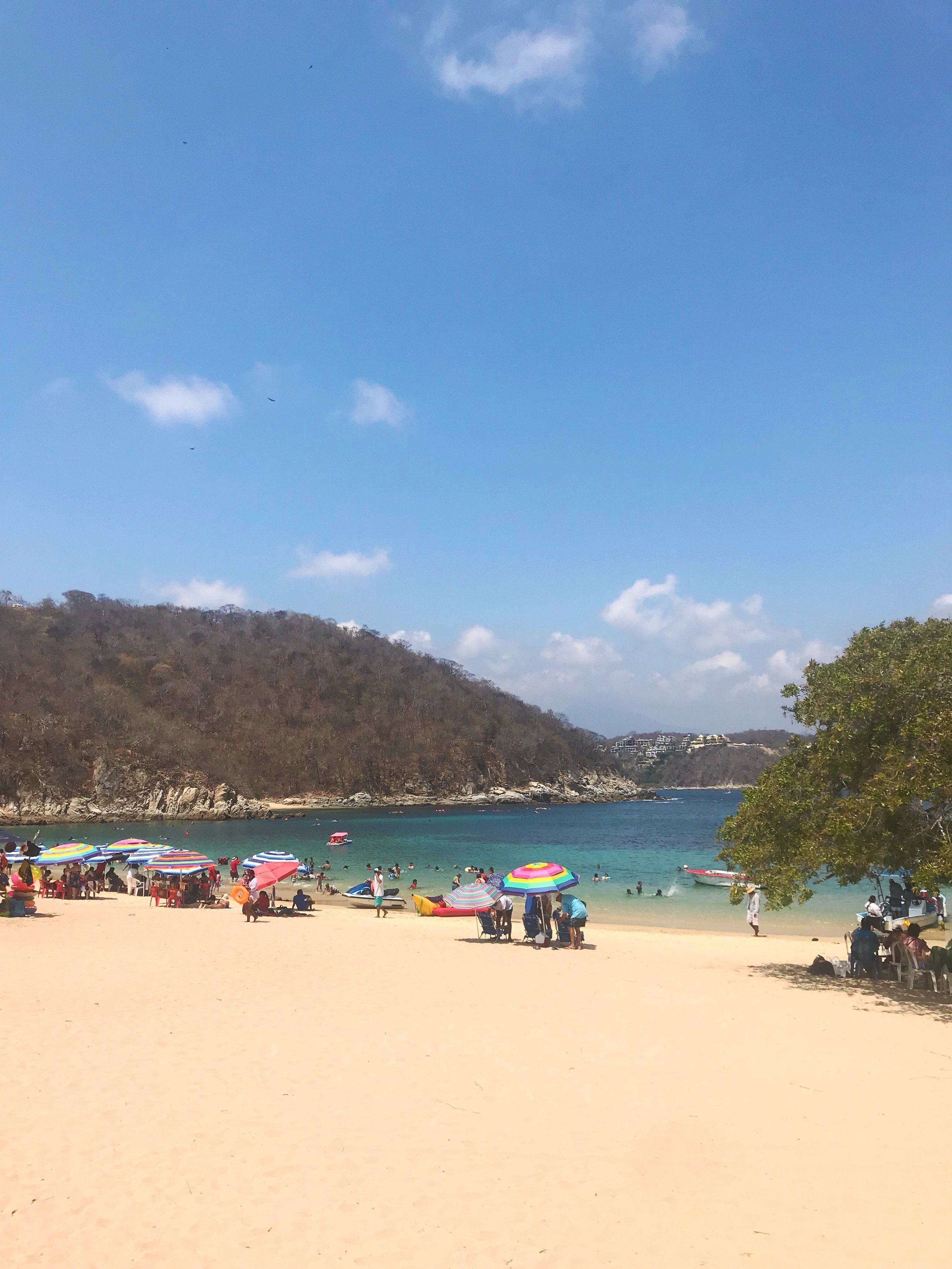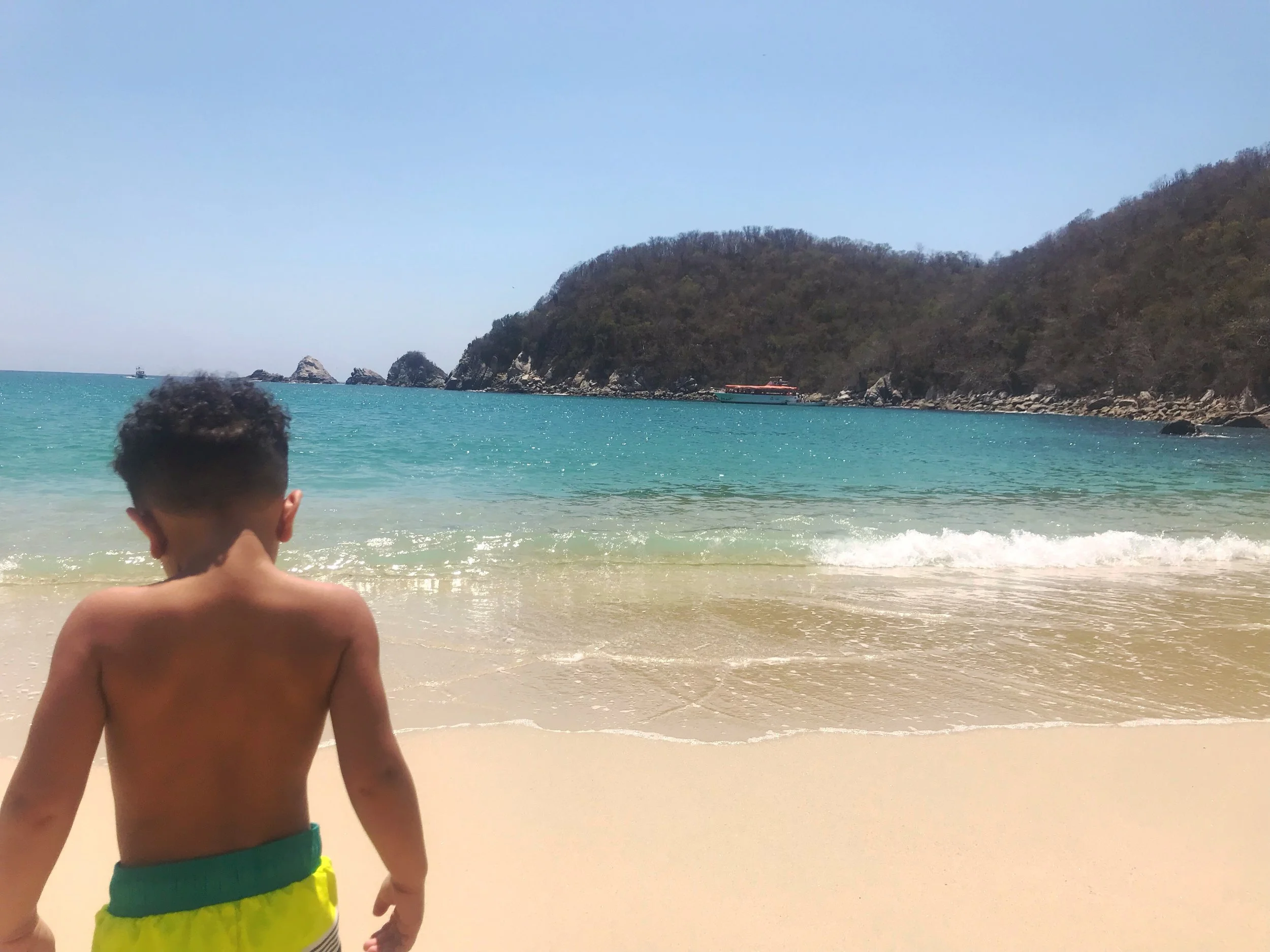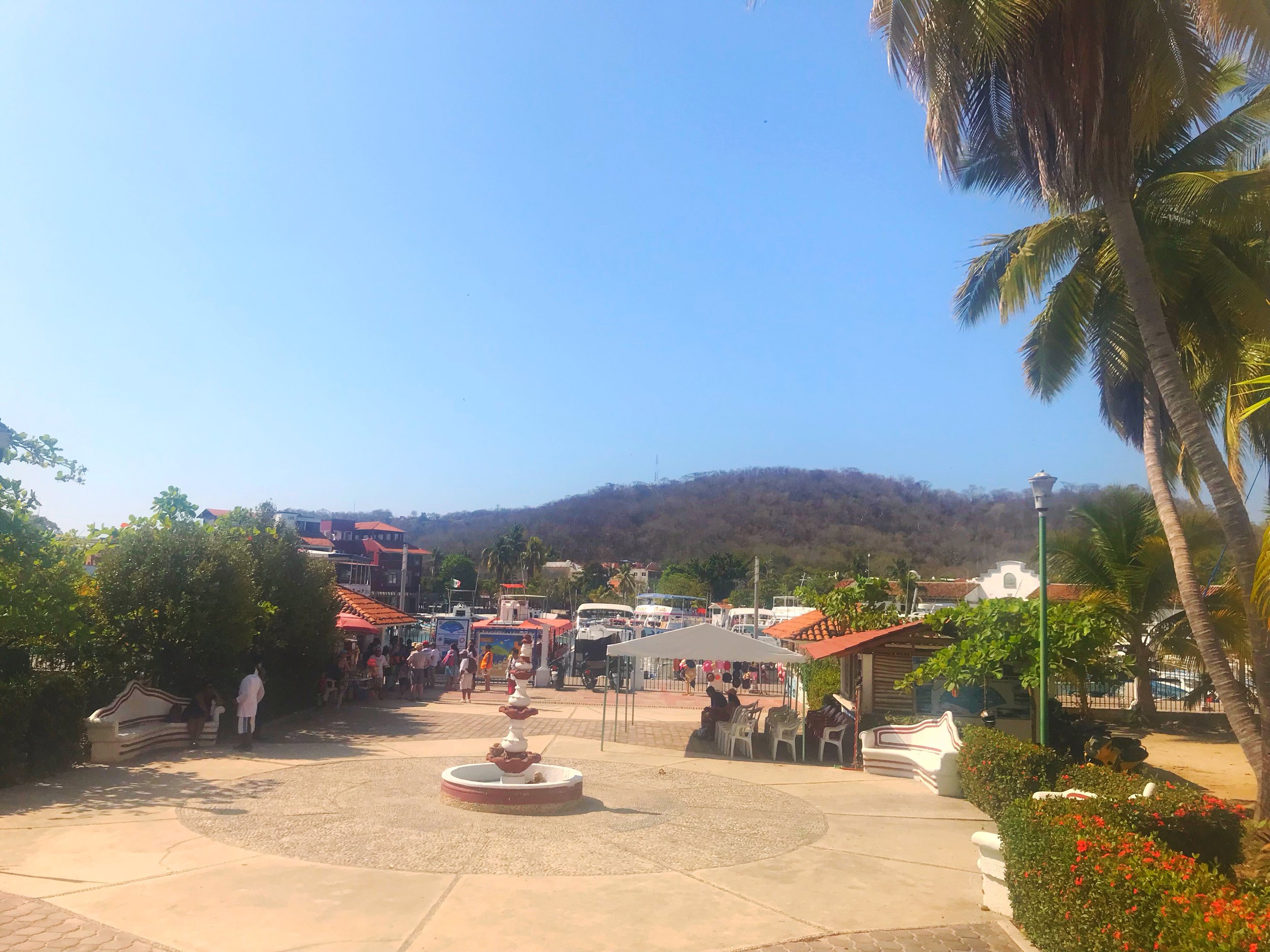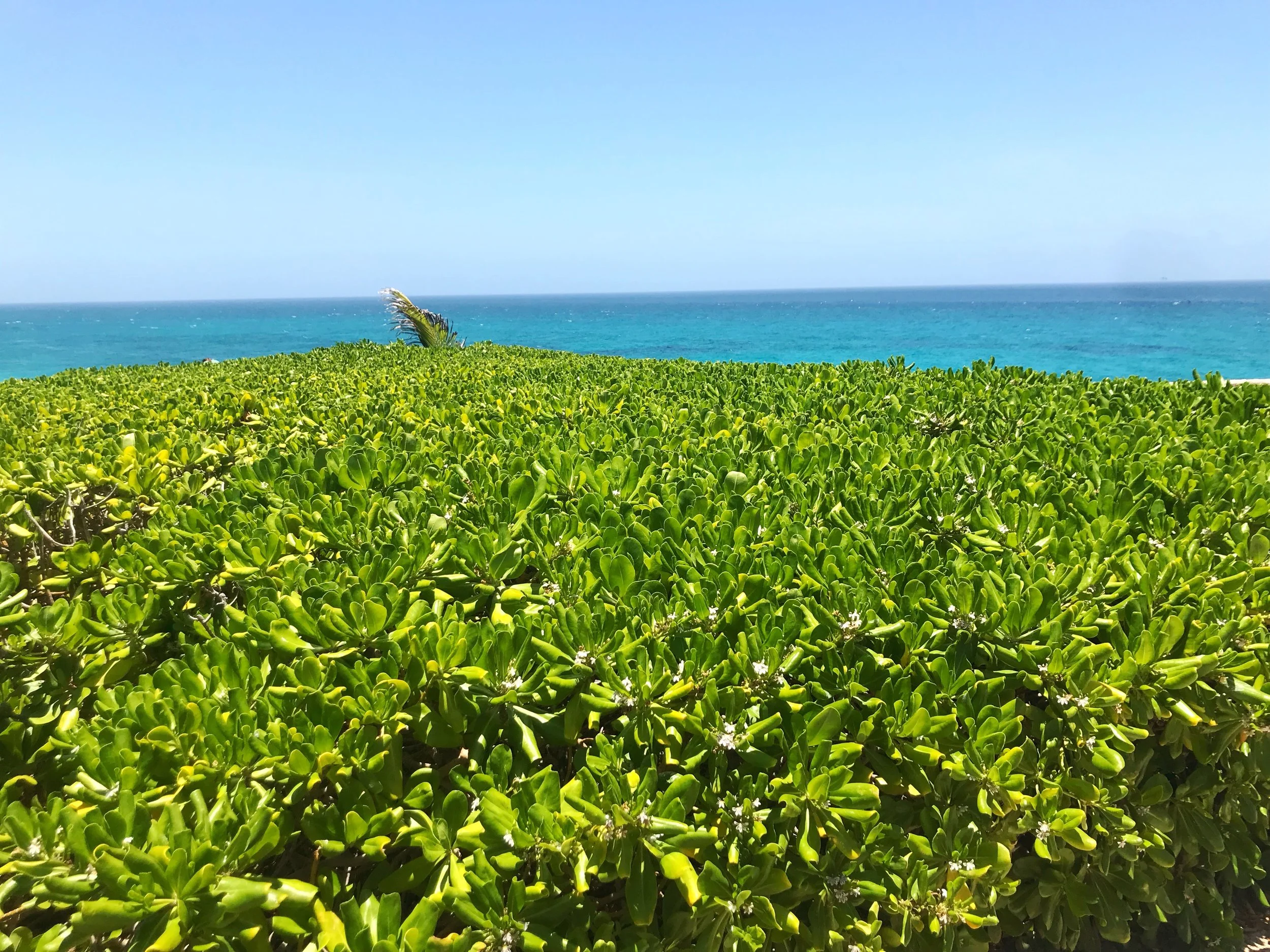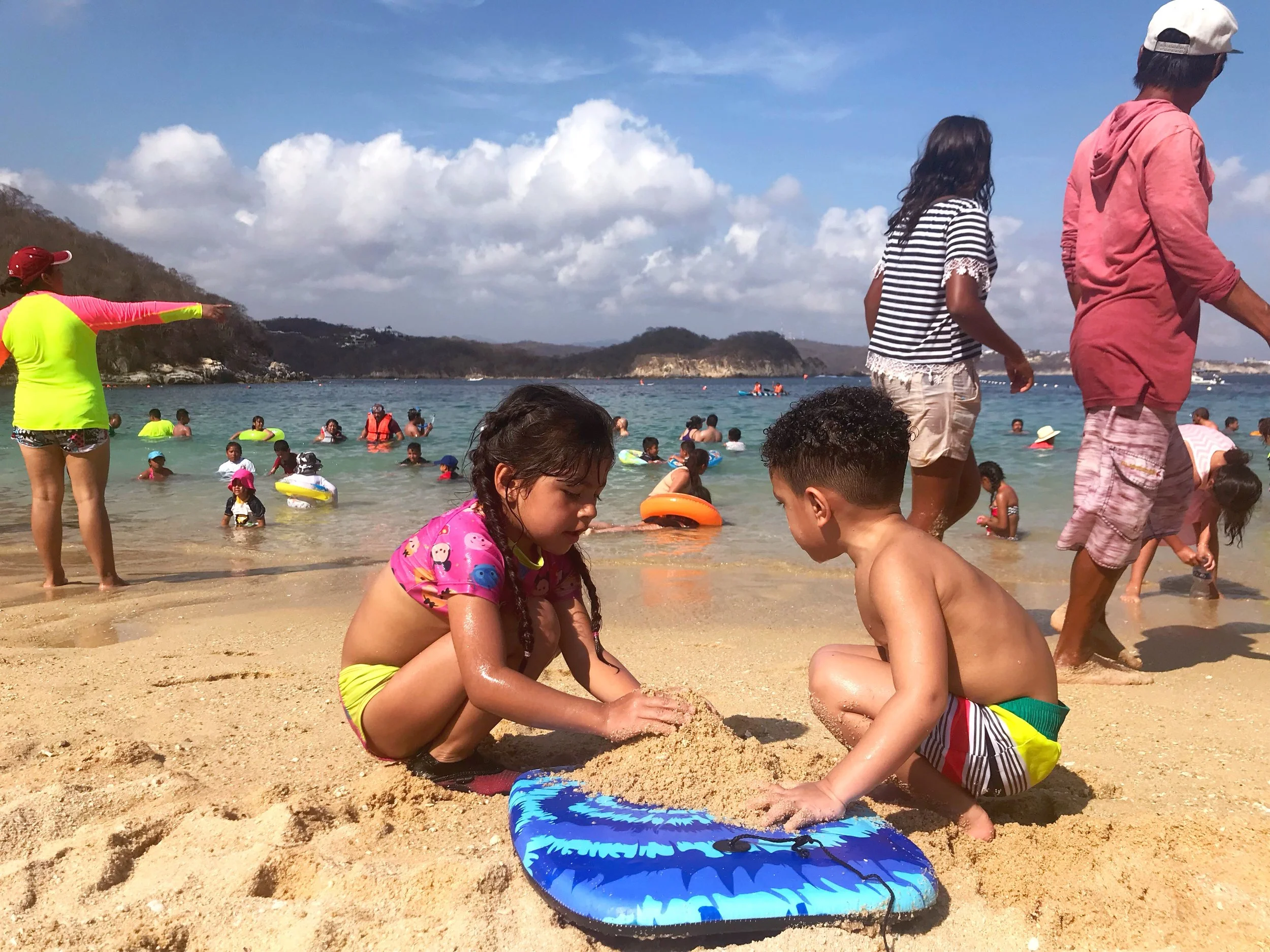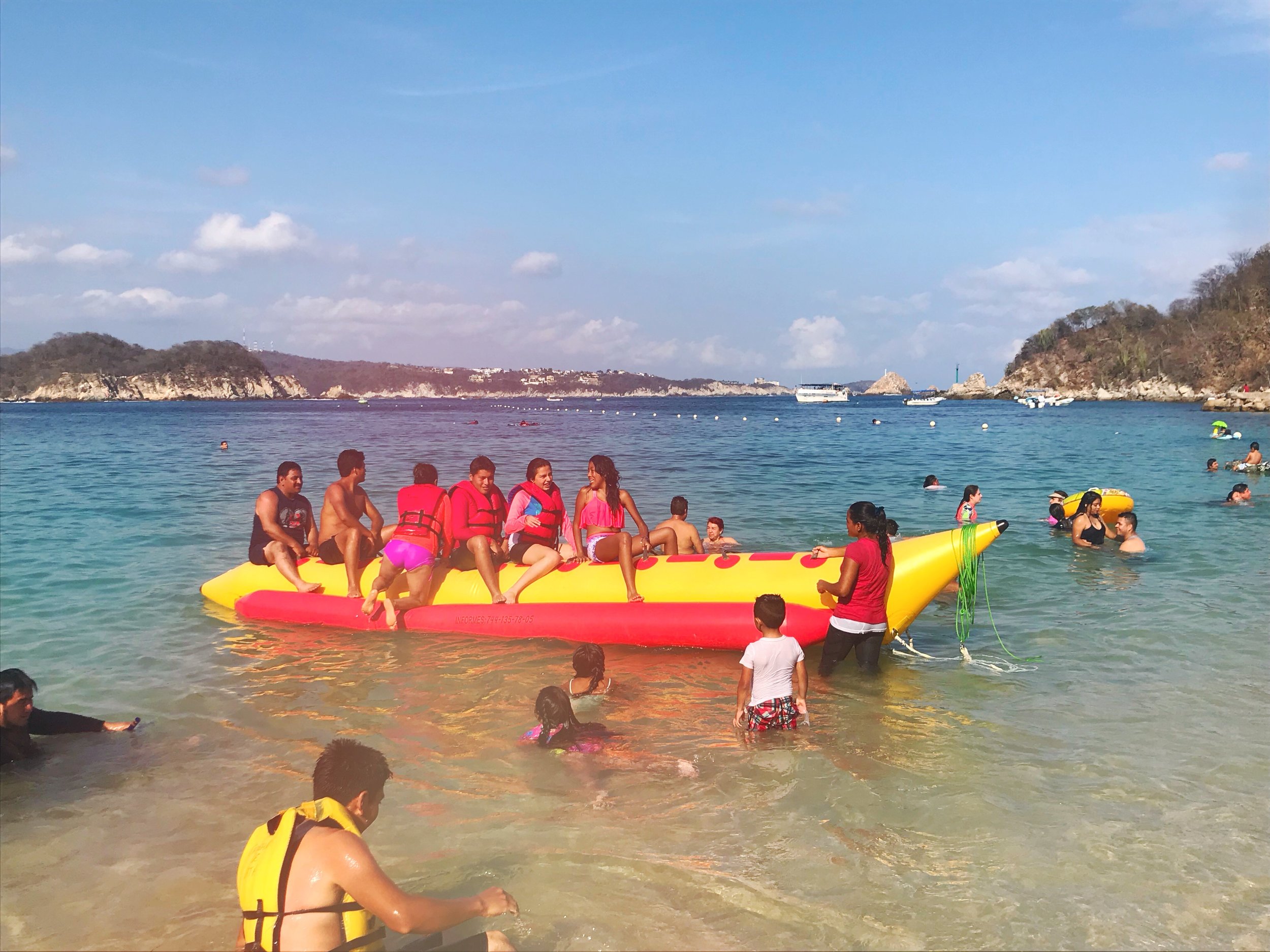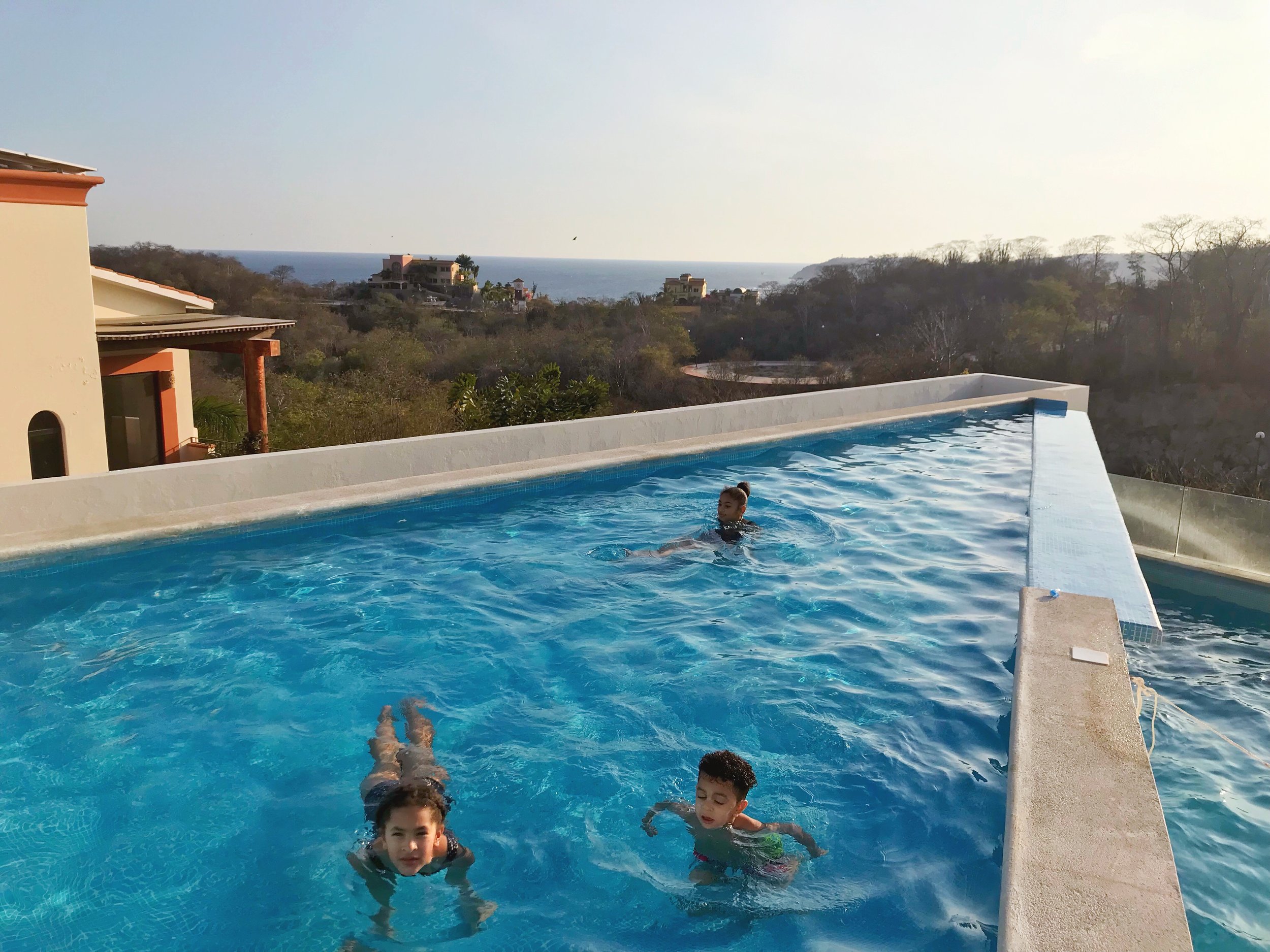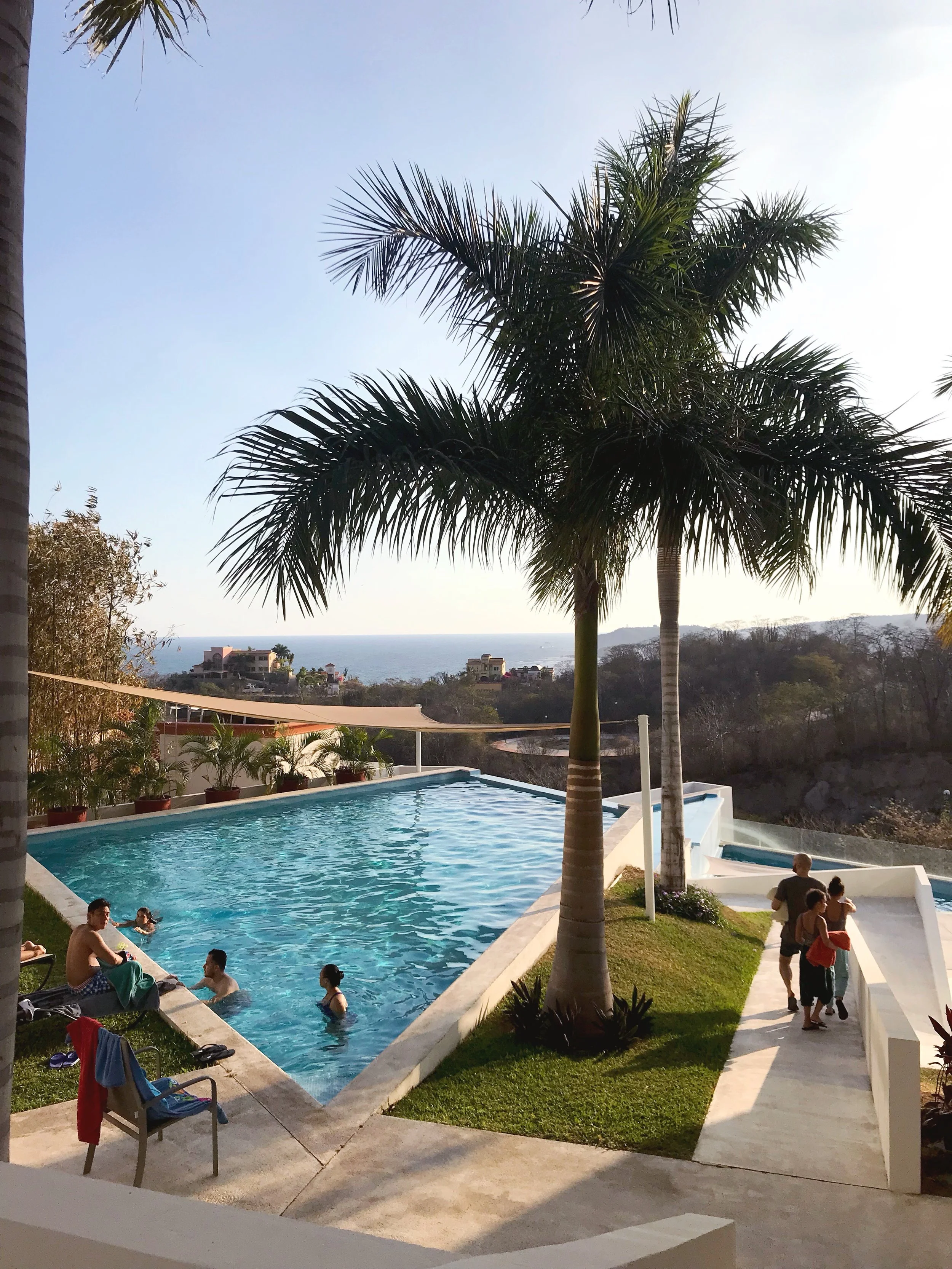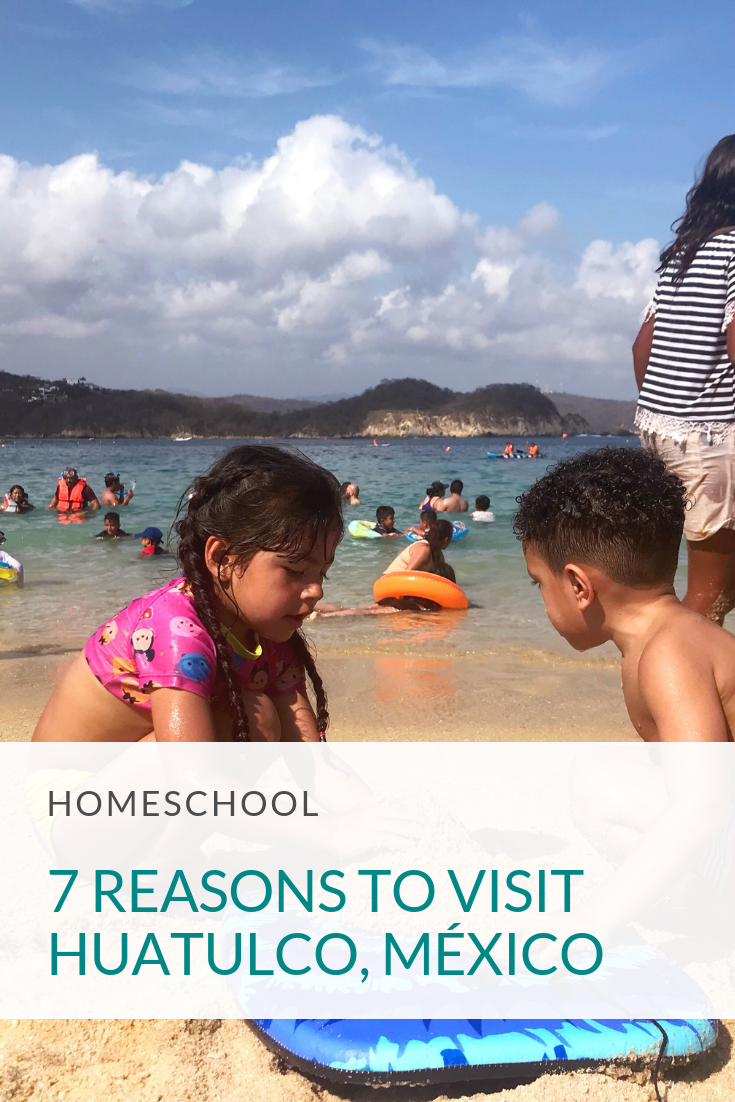Huatulco, México
México is an atonishing country. Every region is diverse with its own food, clothing, dialects, traditions, dance and Indigenous people. You could visit one area of México and then visit another and experience something totally unique. From the metropolis of México City and its neoteric revival to colonial towns, the Caribbean Sea, Pacific Ocean, jungles, deserts, ancient ruins, lush valleys, mountain ranges—not to mention an incredible array of biodiversity.
México is a labyrinth of majestic beauty.
Many never experience this beauty as they define the country by violence, drug lords and border disputes. Many who travel to México stay on what appears to be the “safe route” and limit themselves to all-inclusive vacations.
There are many lesser-known areas of the country that deserve a visit. And while Huatulco is a beach destination, it’s one of those places that should not be missed.
Where is Huatulco México?
Huatulco (wah-tool-ko) is located in the southeastern region of the state of Oaxaca. Oaxaca (wah-ha-ka) is seeped in Indigenous culture and pride; over 350,000 Zapotec and 240,000 Mexitec peoples call this area home, and over sixteen other Indigenous groups are officially registered within the locality. At least half of the population of Oaxaca still speaks Indigenous languages, and they each have distinct foods, rituals, dress and customs.
The Huatulco area gives a beautiful glimpse into this rich heritage, while also providing beach vibes and access to a nature-lovers utopia. The area is not as popular as other beach regions in México such as Cancún, the Riviera Maya, Puerto Vallarta and Cabo, but this adds to its appeal. There are not many tourists who frequent the area, but it has become a popular retirement destination for Canadians.
How to get to Huatulco México
We flew directly to Huatulco from Minneapolis on Sun Country Airlines. These seasonal flights begin in January and run through April. Sun Country offers direct, low-cost fares from the Minneapolis/St.Paul area to varying cities across the U.S., México, Costa Rica and the Caribbean.
Volaris is a low-cost Mexican carrier that offers inexpensive flights to Huatulco from cities across the U.S. such as Chicago, Los Angeles and Houston.
Interjet is another carrier based in México with affordable flights to Huatulco from the U.S.
West Jet is a Canadian airline with great deals on flights from Canada.
Larger airlines also have flights to Huatulco from the U.S., many via México City. There are also flights available from Oaxaca (city) and other parts of México.
Where to stay in Huatulco México
There are many lodging options in Huatulco, in varying parts of the city.
Hotels. There is an abundance of hotels in Huatulco, many boasting beautiful views of the Pacific Ocean. There is a variety of well-known chain hotels, small boutiques and budget-friendly options as well.
Airbnb. I’ve used Airbnb since 2011, and while the platform has dramatically changed since the early days, as for now, it’s still my go-to for unique and affordable housing in cities around the world. Airbnb has hundreds of thousands of lodging options from around the world: single bedrooms, entire apartments or homes, a treehouse, boat or even a tent. We spent a week at an apartment we found through Airbnb; it was affordable, had amazing views of a bay and was within walking distance to one of Huatulco’s many beautiful beaches.
Hostels. There are a variety of hostels in the Huatulco area that are affordable and offer unique experiences. I’ve stayed at different hostels all over the world with the kids since they were infants. In fact, I am still friends with the owner of the hostel in Malacca, Malaysia that the girls and I spent a month staying at back in 2012. I am also still friends with people from Germany, Poland and the U.S. that we met at this hostel. Hostels provide affordability and the opportunity to build a travel community.
Sun Country, Minnesota’s hometown airline
7 reasons why huatulco is méxico’s best kept secret:
1. the bays
Huatulco is home to nine major bays, many of which are protected and cared for by Indigenous tribes. Each bay is stunning and located in different areas around town. They are surrounded by beautiful beaches, and sailing, scuba diving, snorkeling, fishing, swimming and surfing are popular activities to enjoy.
Huatulco’s 9 most popular Bays
Santa Cruz Bay
Our Airbnb was right near Santa Cruz Bay. It’s one of the most popular areas of Huatulco, and we were near grocery stores, shopping, cafes and great beaches.
Chahué Bay
Chahué Bay is filled with beautiful beaches and the marina is located in this area. Crucecita, the main square where many shops and restaurants are, is near Chahué Bay and it’s a fun area to hang out.
Riscalillo Bay
Only accessible by boat, Riscalillo Bay is home to a beach of the same name great for snorkeling, scuba diving, fishing and swimming.
Cacaluta Bay
Made famous by the film, “Y Tu Mamá También,” the beaches of Cacaluta Bay are gorgeous. These beaches are very secluded as they are hard to reach, but it’s worth the trip if you can make it.
Conejos Bay
Conejos Bay is another secluded area that boasts four beautiful beaches. It’s perfect for swimming, snorkeling, diving and fishing.
Chachacual Bay
With two beautiful beaches, Chachcual and La India, Chachacual Bay is another option to beat the crowds. The bay is only accessible by boat offering a private and tranquil experience.
Organo and Maguey Bays
While Organo and Maguey are separate and unique bays, they are right next to each other. Maguey is the easiest to get to as it can be accessed via boat or road.
San Augstín Bay
If you love camping, San Augstín is the bay for you. Its beaches are perfect for diving and there are numerous restaurants to choose from
Tangolunda Bay
If you’re looking for golf courses, exclusive hotels and expats, then Tangolunda Bay may be the place for you. But if you’re also looking for more beautiful beaches, this is also a great location as it boasts five of them.
San Agustín Bay
2. the seafood
I must let it be known that I don’t eat seafood.
Yes, I have tried it.
Yes, I have tried it in adulthood.
No, I still don’t like it—not even shrimp or lobster.
Now that we got that out of the way, let’s talk gastronomy. Papi came with us on this trip and he’s a huge fan of all things that come from the ocean, and on his word, Huatulco is a seafood lover’s paradise.
Because Huatulco is a coastal city, fresh seafood is widely available. From daily catches of a wide variety of fish to shrimp, lobster, oysters—and everything in between—Huatulco has it all.
Restaurants all over the city are filled with seafood specialties. Many of the restaurants in Huatulco are locally-owned; they are not owned by foreigners or large companies.
You will also find many women at the beaches in Huatulco selling their own seafood delights—support these small businesses as well. According to a UN Women report, economic empowerment is a fundamental force in creating gender equality. Many of the women selling seafood, pastries and other delights on the beach are caring for children, parents and other family members. They work hard everyday by preparing meals and walking up-and-down beaches to provide for themselves and their loved ones. These women’s entrepreneurial spirit and drive deserve recognition—remember to honor their hard work by purchasing from them.
Most items will be very inexpensive, so be sure to give them something extra—not as charity but as a tip for their service. It’s not required nor expected, but if you’re paying $3 for a plate of oysters that you’d normally pay $60 for at home, give a little extra.
Restaurante Vé El Mar in Santa Cruz
3. huatulco beaches
I’m not going to lie, I’m a bit of a beach snob. I love white sand and turquoise waters, and I’m not a huge fan of the Pacific Ocean.
Am I the only one who’s like this?
Huatulco is located on the Pacific Ocean so I was was a bit hesitant to spend a week there, but the beaches in Huatulco are absolutely stunning. The sand is soft and with a beautiful lightly-toasted coconut hue, and the water is clear and sparkles like jewels. The only other time I’ve seen the Pacific Ocean look like this was in San Juan del Sur, Nicaragua.
There are over thirty different beaches in Huatulco, so if you are a beach lover, it’s the place for you. I love the tropics but I can’t spend an entire week only going to the beach, but one could literally revolve an entire vacation around visiting the varying ones in the area. Amongst the popular, known Huatulco beaches there are also loads of exquisite hidden ones that are almost secluded and only known by residents. We became friends with a family from the area and were able to enjoy one of these hidden gems.
There are plenty of locally-owned restaurants at many of the popular beaches, providing a variety of delicious food to choose from.
Most of the beaches in Huatulco we went to were great for swimming, snorkeling and perfect for kids.
Riscalillo Bay
4. It’s clean
Huatulco is one of the cleanest cities in the world that I’ve visited. Normally, I don’t highlight whether a city is “clean” or “dirty” because I find these types of discussions in travel racist, elitist and outright obnoxious. There was something special about why Huatulco is so clean and well-groomed, though, that I felt should be shared.
Huatulco is kept in an immaculate manner not because Canadians decided that it was a great place to retire and start a “clean up Huatulco” project. Most importantly, Huatulco isn’t pristine for the sake of tourism.
Huatulco is clean because the residents love their city and they care for it for their own pleasure.
The beaches in Huatulco are immaculate because of the people, for the people to enjoy—not for the gratification of white tourists. In fact, many of the beaches and bays are under the control of Indigenous nations and they care for them as their ancestors did in the past.
The streets were clean. The parks were clean. The plaza was clean and filled with families enjoying their city as it belongs to them and not to tourists and expats.
There are recycling bins over the city, and Huatulco has one of the few certified green airports in the world. The pride that residents of Huatulco have for their home is obvious, and their deep sense of ownership of it was empowering to witness.
Often in travel and tourism, visitors forget that the purpose of a destination’s existence isn’t for their pleasure; countries and cities belong to the people who live in them. The residents of Huatulco display this beautifully, predominating what is rightfully theirs.
Santa Cruz, Huatulco
5. its Natural Environment
Besides a variety of beaches and bays, Huatulco and its surrounding area boasts a national park, nature reserves, mountains and waterfalls. It also possesses one of México’s largest ecosystems. The Bahías de Huatulco National Park is over 29,000 acres with more than 9,000 plant species; it is also home to over 700 bird varieties, 470 different reptiles, 260 fauna species and more than 100 sea species. One could spend all day searching for iguanas, geckos, snakes, salamanders, hawks, dolphins, whales, white-tailed dears and more.
Magic Falls and Llano Grande are popular waterfalls in the area. For those who love hiking, swimming in crystal waters and venturing through mountains, this is a great way to spend the afternoon. There is even a coffee plantation near the Magic Falls.
Hagia Sofia is a large argo-ecological reserve located right outside Huatulco. The reserve uses sustainable practices such as composting, organic farming and alternative energy sources. Their mission is to train future generations in these same disciplines to preserve the integrity of their land. It would be easy to get lost in the magic of Hagia Sofia swimming near the waterfall, eating organic food and searching for butterflies. For avid hikers, there are plenty of trails that lead to peaceful rivers, a wide variety of flowers and vegetation, plus beautiful mountain views.
Just about a two hour trip outside of Huatulco leads you into the lush Sierra Madre Mountains. Someone looking for peace and tranquility will find exactly that here. There are a number of guest houses in the area overlooking rivers, greenery and, of course, the mountains.
Huatulco, México is the perfect place for the eco-friendly and environmentally conscious traveler.
6. the Indigenous Culture
I don’t have time to write a dissertation on colonial and post-colonial anti-Indigenous sentiments across Latin America and the long history of abuses against its native peoples. Racism, classism and colonial-era caste systems are still rampant in Latin America. The race and class divides are obvious with white Latinos in positions of power, ownership and wealth. Afro-Latinos, Indigenous peoples, the working class and poor are disenfranchised and underrepresented.
I know you must be thinking, “Iliah, this sounds horrible but how is this different than any other part of the world?”
It is true that the divides of race, ethnicity, power and class exist all over the world, however, this segregation is especially prevalent in Latin America. It often feels like one is stepping back in time when in the region.
In most tourists areas of México, visitors are kept separate from local communities. Most encounters one may have with dark-skinned and working-class Mexicans will be in service-type positions. Wealthier white and Mestizo Mexicans have the opportunity to enjoy the beauty of their country, but it’s rare to see Indigenous, dark-skinned Mexicans enjoying these destinations alongside tourists and their countrymen.
In Tulum, Cancún and the Riviera Maya, which is the heart of the Mayan empire, one rarely sees Mayan people enjoying the beauty of their ancestral lands in a position of equality with others. Large chunks of beaches in Cancún are privatized and owned by international hotel chains, and most locals cannot afford the attractions that tourists easily enjoy.
However, in Huatulco, we were blown away by the sheer power of the Indigenous force of the area, and by the fact that we were able to be side-by-side enjoying the beauty of their city with them. Indigenous people were eating in restaurants with us, not just serving us food. Indigenous people were at the beaches in Huatulco eating, laughing, swimming and enjoying themselves and their families along with tourists and expats in equality. Indigenous people were at the grocery store shopping with their children and doing everyday life. I know this may sound trivial to some, but it is actually a huge deal and a testament to the area—I’ve never seen this in any other tourist area of México.
“In Huatulco, the Indigenous peoples are not mere attractions for the sake of foreign curiosity. In Huatulco, Indigenous peoples live life and occupy the space that is rightfully theirs, unapologetically. ”
Playa La Entrega
Playa La Entrega
7. it’s affordable
As a family with three children, I’m always looking for affordable places to travel to. In order to travel frequently, I try to choose destinations that allow us to have memorable experiences without requiring half of one’s life savings. Working on a tight budget has always been the way I’ve traveled, and it’s one of the reasons we’ve been able to do it frequently over the years.
I found Huatulco to be much more affordable than other Mexican beach towns such as Cancún, Tulum and Isla Mujeres—I’ve never spent time in Puerto Vallarta or Cabo, so I cannot compare between them.
As a family, we could eat out for dinner for around $30-$40, and we saw Capitan Marvel and spent $16 on five tickets, popcorn and four slushies. Our six-hour boat ride that took us around to see the bays cost $80 total for five people, and the girls were able to snorkel at no extra fee with the gear provided—it was a Spanish-speaking tour which could explain the economical price.
There were many Airbnb options for budget-conscious travelers, most of which had swimming pools and were under $100 per night. Our modern 2 bedroom/2 bathroom condo with bay views and three pools was around $60 per night.
I truly appreciated that we were able to enjoy ourselves in Huatulco and indulge in a few luxuries like eating out for dinner a few times during the week. It was a great reminder of how life in the United States becomes burdensome, and that there are places around the world that offer a fuller life.
Swimming at our Airbnb
I left Huatulco awe-inspired by its natural beauty and by the power of the thriving Indigenous communities and cultures present in the region. Communities who were, at one time, ravaged by colonizers and their diseases yet survived.
Huatulco’s great beauty is a testament of Indigenous existence being an act of resistance against the evils that have transpired against México’s first peoples.
To preserve language is an act of resistance.
To preserve gastronomy is an act of resistance.
To control land is an act of resistance.
To protect and care for that land is an act of resistance.
To enjoy one’s own space is an act of resistance.
Living is an act of resistance.
would you consider a trip to huatulco?
Further Reading:
How To Save Money For Family Vacations
A Day Trip To The Las Coloradas Pink Lake With Kids
Affordable Gifts For Kids Who Love Travel
When Is The Best Time To Visit Egypt?
5 Documents Every Family Needs For A Trip Abroad
6 Essential Items Every Parents Needs In Their Personal Bag For A Flight
Dahab, Egypt: A Red Sea Paradise In The Desert
Pin this article on Pinterest using the photo below if you thought this post was useful!

